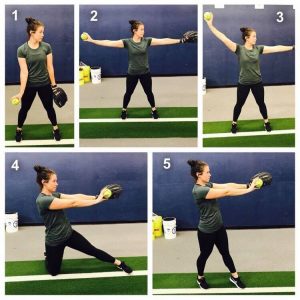Pitching Pointers: Back to the Basics

The summer softball season has officially come to an end. If you are a softball pitcher, there is a good chance you may have developed a bad habit or two. This is common as pitchers throw in more games than have practice time in the summer months. When pitchers throw in game after game, the mechanics and form begin to deteriorate. It’s important that after the summer season concludes, pitchers go back to the basics and spend time on drill work and form.
Line the Ball: Always practice pitching with a lined ball. This goes for overhand throwing as well. Put a piece of electrical tape across the “C” grip for overhand throws and fastballs. Other movement pitches may require the line to run across the “Two-seam.” It’s important to have an extra ball handy if this is the case. Lining the ball helps a softball pitcher with three things. It sets up the correct grip for every pitch, it tells the pitcher and the catcher if the pitcher produced the proper spin on the pitch, and if the line on the ball stays lined up with the Powerline on the ground, the pitch will go straight and have a better chance of being a strike.
The Powerline: The most important pitching tool for pitchers of all ages. The Powerline is the imaginary line that runs from the center of the pitching mound and continues all the way to the middle of home plate. If pitchers can keep their toes, arms, body, and the ball lined up on the Powerline throughout their pitch, the chance of throwing a strike increases. It is encouraged to practice all of your pitching and warm-up drills on a Powerline.
The Open Position: It’s important that pitchers get open during their pitch. If pitchers are standing on the Powerline, with their toes touching the line, this is the open position. Catchers should lose sight of the front of the pitcher’s shirt or jersey for a split second at the top of the arm circle if the pitcher gets fully open. Getting open benefits the pitcher in several ways. It will give their arm more room to come straight through on the Powerline with no interruptions. It also makes it easier for pitchers to spot pitches, learn and execute movement pitches, and it will set them up to throw harder because the hip will come through after the arm.
Below are five pitching warm-up drills that pitchers can use to help develop and maintain proper form and mechanics while using the Powerline and working on staying open.
Wrist Flicks The most important, yet most overlooked pitching drill. Line up the toes on the Powerline, connect the throwing elbow to the back hip, so only the wrist is mobile. Position the glove thumb to thigh and keep it there. Place the ball to where it is on the line, and so the catcher can see it. Stress the use of only the wrist during this drill. The purpose of wrist flicks is to build wrist strength and muscle memory for the release point of the pitch.
T Drill: Line up the toes on the Powerline and lift the arms straight outward into a T position. Do not use the lower body during this drill. The most important part of this drill is positioning the ball so that the catcher can see it at the beginning of the drill and for the whole way down to the release point. Both arms should come down at the same time and work together to keep the pitcher centered and balanced.
K Drill: Line up the toes on the Powerline and raise the arms up into the T position to check the ball alignment. Next raise the throwing arm up into a K. If the catcher is looking at the throwing arm, the ball should be facing away from the catcher. Pitchers can take a step during this drill. Take the step and allow the arms to come down to the release point together. The challenge most pitchers face during this drill is to remain in the open position with their hips.
Kneeling Arm Circles: Begin by dropping down to the knee of the throwing arm on the Powerline with the hips in the open position. The other leg should be out and straight in front of the pitcher. Point the glove and ball directly at the catcher with the shoulders in line to start this drill. Push the arms up past the head, separate, then hit the K, T, and wrist flick position all in one motion. Since there are no legs involved in this drill, the pitcher must create her arm circle and speed.
Standing Arm Circles: Line up the toes on the Powerline, then pivot the feet so that the shoulders are facing the catcher. This is the only drill in the warm-up progression where the pitcher will start in the closed position; it is her job to get open from here. The catcher should see the ball all the way around the arm circle. If the catcher loses sight of the ball, it’s likely that the pitcher did not get open or that the arm went behind the body. In this drill, take a step for momentum and push both arms up into the circle while opening up the hips. The pitcher should hit the K, T, and wrist flick position in this drill and her full pitch.






